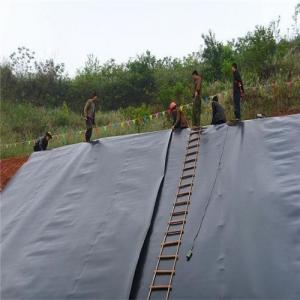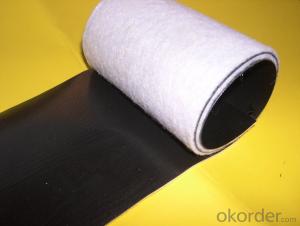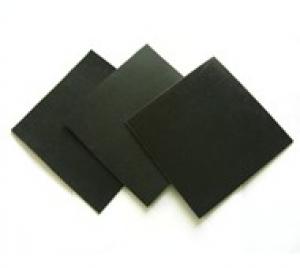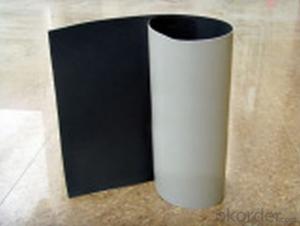HDPE Pond Liner 1mm Geomembrane
- Loading Port:
- China Main Port
- Payment Terms:
- TT or LC
- Min Order Qty:
- -
- Supply Capability:
- -
OKorder Service Pledge
OKorder Financial Service
You Might Also Like
1.Product Description
Our product was proved as good physical and mechanic performance, strong deformation adaptability, ultra-violet radiation, oil and salt,
alkali and corrosion resistance, long operational life, good waterproof, drainage, anti-seepage and damp proof effects, complete width and
thickness specifications.
1.base liner applications under roads, railways,
2.secondary containment for above ground tank farms,
3.They are also used for waterproofing of buildings and other similar structures.
2.Product Characteristic:
1) Environmental protection, sanitation (such as solid waste landfills, sewage treatment plants, power plants Chi-conditioning, industrial,
hospital solid waste, etc.) .
2) Water (such as rivers, lakes and reservoirs of the anti-dam, plugging, reinforcement of the canal seepage, the vertical wall of the heart,
slope protection, etc.).
3) Municipal Engineering (subway, on the ground floor of the building, planted roof, the roof garden of anti-seepage, sewage pipes lining,
etc.).
3.Product Specifications:
1.Thickness : 1mm,
2.Length: 100 mm; width: 100mm
3.Material: HDPE.
4.Color: Black or as required
4.Reference Picture



- Q: Is non-woven composite geomembrane same to geomembrane?
- the mixed application of geotextile and geomembrane reaches the engineering requirements. Firstly, introduce geotextile: Geotextile is a kind of new construction materials in civil engineering, silk or short fiber are paved in nets through equippments and technology, then the needle puncture technology will make fabrics interwoven together, making the fabric standardization, making the fabric soft, full, thick, hard and satisfy the thickness requirements, short fiber geotextile or short fiber geotextile's tear-resistance strength is higher than short fiber. fiber is soft and has certain tear-resistance ability. main function: Filtration, drainage, reinforcement function specification 100 grams per square meter, 800 grams per square meter, it's main material polyester fiber has excellent water permeability, filtration, durability and ability to adapt to deformation, and surface drainage capacity. geomembrane plastic film as seepage-proof base material, the seepage-proof performance of non-woven composite soil engineering impermeable material, two cloths and membranes mainly depends on the seepage-proof performance of plastic film. geomembrane is a kind of flexible?material polymeride basic material, high waterproof material proportion, good extensibility,high?adaptability?to the?deformation, corrosion resistance, low temperature resistance, frost resistance.
- Q: Is black HDPE geomembrane eco-friendly?
- Raw material of HDPE geomembrane is HDPE particles, adding carbon?black to become black. It is buried underground to prevent hazardous liquid leakage. So HDPE geomembrane can be considered as environmentally friendly.
- Q: What are the requirements for geomembranes used in industrial waste containment?
- The requirements for geomembranes used in industrial waste containment typically include qualities such as chemical resistance, durability, and impermeability. They should be able to withstand exposure to various chemicals and liquids without deteriorating or causing contamination. Additionally, they need to be strong and durable enough to withstand physical stress and potential punctures or tears. Impermeability is crucial to prevent any leakage or seepage of hazardous waste materials. Overall, these geomembranes must meet stringent standards to effectively contain and safely manage industrial waste.
- Q: Is far infrared ray electrothermal film good?
- Distinguised from the dot mode heating system represented by radiator, air conditioning as well as heating radiator and the streamlined heating systemis represented by heating cables, the electrothermal?film heating system is a LC supply heating high-tech product that is invented by using modern aerospace flight technology in the field of facial heating. The far infrared electric heating film is still very good.
- Q: What are the codes for acceptance of constructional quality of concrete structures?
- 1, improve basic provisions of acceptance. 2, add provision of inspection lot expansion of certified products or continuous qualified products. 3, delete provisions for acceptance of template deismantle. 4, add provisions for acceptance of moulded rebar and other rebar new technologies. 5, add provisions for acceptance of unbonded prestressed steel fully enclosed waterproof performance. 6, improve provisions for site acceptance of premixed concrete. 7, , improve provisions for site acceptance of precast components. 8, add provisions for acceptance of objects which has deviation in structures position and dimension. 9, add a method of checking structural entity concrete strength through rebound-drilled core method.
- Q: What is the difference between single-sided laminated film and double-sided laminated film of paper cups?
- Paper cups coated with single-sided laminated film are used to contain hot drinks while paper cups coated with double-sided laminated film contain cold drinks. The double-sided laminating paper cup has a layer of transparent film on its both sides and the cup is smooth.
- Q: Can geomembranes be used in road and bridge construction?
- Yes, geomembranes can indeed be used in road and bridge construction. They are often employed as a barrier or liner material to prevent the infiltration of water, gases, or contaminants into the underlying soil or structure. Geomembranes provide excellent protection against corrosion and can enhance the longevity of roads and bridges by preventing damage from moisture and chemical exposure. Additionally, they can also aid in slope stabilization and erosion control, making them a versatile and valuable component in infrastructure development.
- Q: What is 3m film?
- 3M architectural glass film including the 3M insulation film, the 3M explosion-proof membrane and the decorative glass film Fasara of 3M. 3M architectural glass film family can make buildings more energy efficient, more comfortable, healthier, safer and more beautiful. As early as 1966, the 3M apply for the world's first window film patent. Now, 3M integrates the polyester material, the coated ultra-fine, the thin film technology, polishing and viscose these five core technology, through innovation, it develops series of glass film, being a world leader in film technology.
- Q: Can geomembranes be used in oil and gas storage tanks?
- Yes, geomembranes can be used in oil and gas storage tanks. Geomembranes provide an effective barrier against leaks and contamination, helping to prevent environmental damage. They are commonly used to line storage tanks and ensure the integrity of the containment system.
- Q: Can geomembranes be used for erosion control in rivers and lakes?
- Yes, geomembranes can be used for erosion control in rivers and lakes. They are impermeable barriers made from synthetic materials that can effectively prevent soil erosion by acting as a protective layer. Geomembranes can be installed along the banks of rivers and lakes to prevent water from eroding the soil and causing further damage. They are a reliable and widely used solution for erosion control in water bodies.
Send your message to us
HDPE Pond Liner 1mm Geomembrane
- Loading Port:
- China Main Port
- Payment Terms:
- TT or LC
- Min Order Qty:
- -
- Supply Capability:
- -
OKorder Service Pledge
OKorder Financial Service
Similar products
Hot products
Hot Searches
Related keywords


























